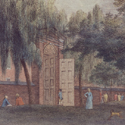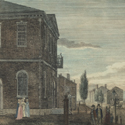The First American Color-Plate Book
After the Catesby splurge in 1772, the Library Company did not buy another color-plate book for over thirty years. The Revolution halted importations, and after the war the Library refashioned itself as the de facto national library in an era of republican virtue and suspicion of luxury.
Thus when William Birch published a series of stunning views of The City of Philadelphia in 1800, the Library Company was not among the initial 150-odd subscribers, even though fifty of its members and five of its Directors were. We did not acquire Birch’s views until the 1850s, when Librarian John Jay Smith gave an unbound set of restrikes from the original plates.
Smith was what was called an antiquary, someone who collected and studied relics of the past. Birch’s views finally entered the collection as documents of local history, fifty years after they were published.
William Birch. The City of Philadelphia. Philadelphia, 1800. Assorted plates, including later restrikes. Gift of John Jay Smith, ca. 1850.
Birch’s 28 folio engravings, in many copies beautifully finished with watercolor, displayed to advantage every aspect of the city’s architecture, commerce, and street life. Birch placed special emphasis on Philadelphia’s civic institutions, and one plate was devoted to the recently completed Library Company’s new building, across the street from the State House. Even that was not enticing enough to sell us a copy, which cost $44.
| State-House Garden, Philadelphia | Congress Hall, and New Theatre, in Chestnut Street, Philadelphia. |

